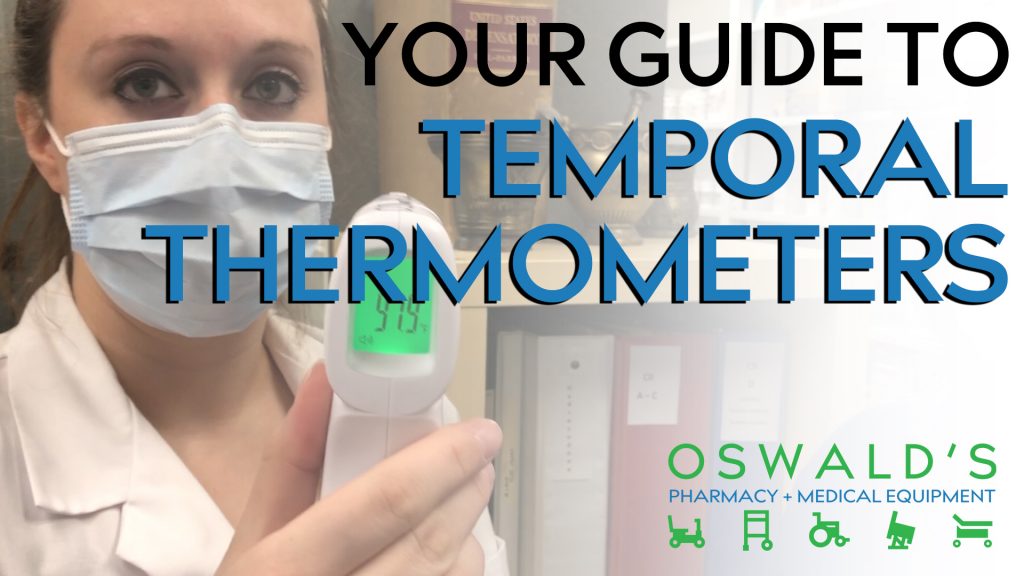I’ve recently gotten a lot of questions about how to use a temporal thermometer. COVID-19 has us all rightfully worried about staying healthy and clean–even when it comes to taking our temperatures. Temporal thermometers can help prevent touching due to being a contactless thermometer.
We also made a quick YouTube video about How to Use a Contactless Thermometer:
How to Use a Touchless, Temporal Thermometer
- Remove hair and wipe any moisture away from the forehead, if necessary.
- Turn the thermometer on à (some models just require you to pull the trigger to turn it on)
- Hold thermometer toward the center of the forehead, about ½ to 2 inches away from the forehead (or as directed by manufacturer’s instructions)
- Keeping the head still, press the trigger or button to take a temperature reading.
The manufacturer of the thermometer you use should have information on how to optimally use it. Be sure to read and follow the instructions provided by the manufacturer on how to obtain the most accurate temperature.
The average oral temperature is 98.6 degrees Fahrenheit (37 degrees Celsius).
A temporal thermometer will read at about 0.5 to 1 degree lower than an oral thermometer, so you need to add 0.5 to 1 degree to get what your temperature would read orally. For example, if your forehead temperature read as 98.5°F, you could actually have a low-grade fever of 99.5°F or higher.
Example temperature differences in the table below*
| FOREHEAD (°F) | ORAL (°F) |
| 98.4–99.3 | 99.5–99.9 |
| 99.4–101.1 | 100–101.5 |
| 101.2–102 | 101.6–102.4 |
| 102.1–103.1 | 102.5–103.5 |
| 103.2–104 | 103.6–104.6 |
Thermometer Types Pros and Cons
Oral Thermometer Pros
Most oral thermometers can get an accurate temperature reading in under a minute.
Digital thermometers are easy-to-use and appropriate for all ages.
Oral Thermometer Cons
Manufacturers of oral thermometers often recommend a 15-minute wait between eating/drinking and taking a temperature.
Older oral thermometers may require a user to keep their mouth shut for an extended period of time. This can be difficult for young children or those with conditions that affect breathing.
Temporal Thermometer Pros
Most temporal thermometers can get a fairly accurate reading in seconds.
Temporal thermometers are easy-to-use and can be appropriately used for taking temperatures on anyone over 3 months old.
Temporal Thermometer Cons
Many temporal thermometers will be ~1/2 degree off the reading from an oral or internal thermometer. This differs by manufacturer. This is not necessarily a con, as you can account for the temperature difference beforehand.
Temporal thermometers can cost much more than oral thermometers.
Temporal vs. Oral Thermometers: Taking Accurate Temperatures Depends on Age
Different thermometers are recommended based on the age of the patient. The following list gives the most-accurate thermometers for 4 different age groups.
Newborn to 3 Months
Oral thermometer. There is ongoing research regarding temporal thermometers and newborns but a traditional oral thermometer is still recommended for the most accurate readings. Note that rectal thermometers usually recommended for taking infant temperatures. Oral thermometers, however, work better than temporal in the context of this article.
3 Months to 4 Years
Oral thermometers are recommended for the most accurate readings.
4 Years and Older
Oral thermometers for accuracy, temporal thermometers for quick readings. Remember to read the instructions that come with your thermometer to avoid any reading-related discrepancies.
Remember to stay with any child under the age of 12 while taking their temperature. This is for their safety as well as making sure you get an accurate reading.
When to See a Doctor About Your Temperature
You should contact your doctor if you get consistent readings of 100F or over on any oral thermometer for longer than a day.
If you are using a temporal thermometer and get consistent readings of 99.5F or over for more than a day, you may want to call your doctor. You can also use an oral thermometer to verify your temperature (remember, oral thermometers usually read higher than temporal thermometers).
If you have any specific questions about taking temperatures or this article in general, feel free to send me an email or call the pharmacy. We’re open 7 days a week and myself or any other pharmacist on duty will be happy to help.
Sources:
*Temperature graph: https://wa.kaiserpermanente.org
General thermometer fact checking: https://www.mayoclinic.org


